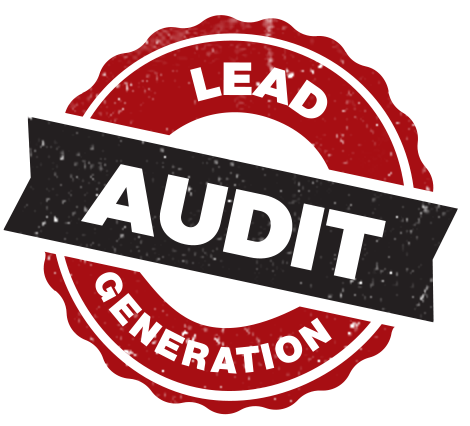
If you’re considering No-Risk Pay Per Click to boost your lead generation, you probably have a few questions.
Let me answer the top five questions contractors ask me when they’re on the fence about trying the program.
#1: “Are The Leads Any Good?”
You bet. Think about it for a second. Why would PPC leads be different than any other type of lead? The types of folks who click on PPC ads are usually the types of folks who want a remodel or home improvement project ASAP—like right now!
Contractors who have had success with PPC report that the lead quality is as good as or better than their other primary lead-generation efforts. Honestly, the only kinds of leads that may be easier to close are referrals and home show leads.
A quick word of caution, though. Digital leads are often champing at the bit to start their projects. If you don’t answer when they call—or follow up that same day—they’ll likely have already moved on to the next contractor. This is why it’s MISSION-CRITICAL to have a 24-hour answering service to catch any calls you miss.
#2: “What Do You Consider A Lead?”
Anyone in your service area who contacts you expressing interest to buy what your company provides. It’s that simple.
We don’t count service calls, hang-ups, repeat callers, or telemarketing calls as leads. A lead is anyone you can potentially turn into a new sale. Period.
#3: “Is The $200 Cost Per Lead Guarantee Real”?
It sure is. If your cost per lead (CPL) is more than $200 for any given billing period, we foot the bill for the overage.
That means…
- If your CPL is $247.23, we pay the extra $47.23 per lead.
- If it’s $324.95, we pay the $124.95 per lead.
- If it’s $200.01, I dig into my couch cushions and find the extra pennies.
There are exceptionally rare instances when we have to set the max CPL to $300. This occurs with only about 5% of clients, but it does happen occasionally. A $300 CPL is due to factors like a hyper-competitive area, abnormally large PPC spending by your competitors, and extreme seasonal competition. In other words—this likely won’t apply to you. And if it does, we let you know BEFORE we launch your campaign.
#4: “How Many Leads Can You Get Me Per Month?”
This depends on your market and the season. It could be 30 per month. It could be 300 per month. Before you sign on as a No-Risk PPC client, we analyze your market to determine a number. Then we let you know the estimated number of leads you can expect, and at what cost per lead.
Whatever the number, we burn the midnight oil to snatch up every available lead in your area.
#5: “Do I Have To Have An Ad Budget?”
No. One thing contractors love most about No-Risk PPC is that they don’t have to dump thousands of dollars into an ad budget every month.
According to industry statistics, the average small- to medium-sized business spends $9,000 to $10,000 PER MONTH on PPC. And that’s with ZERO guarantee their campaign will actually generate any leads.
With No-Risk PPC, you pay ONLY for the leads (and no more than $200 per lead) and a nominal monthly management fee of $1,000. That’s it. No ad budget. No pre-paying. And the leads are guaranteed.
—-
I hope this answers your burning questions about No-Risk PPC.
Now I Have A Question For You…
Why wouldn’t you at least try No-Risk PPC? I’d love to hear your specific reason (if you have one) as to why you wouldn’t at least try a lead-generation service that involves literally zero risk.
Seriously—shoot me an email now with a little note as to why.
Or better yet—shoot me an email and tell me you want to give it a try. After all, you have NOTHING to lose!
Thanks,
-Rich

I was in Boy Scouts as a child.
One of the troop leaders was Mr. Colby. He was an unrepentant geek.
Mr. Colby didn’t talk like a “normal” person. He’d always use five-dollar words made us kids scratch our heads.
If you asked him a “yes or no” question, he’d respond with “affirmative” or “negative.”
If you asked him where we were going on a hike, he wouldn’t say “Beaver Creek” or “Yosemite Valley.” He’d give you the exact coordinates.
One night, we had a big meal by the campfire.
After we ate, Mr. Colby leaned back in his chair. He placed his hands on his stomach and said, “My gastronomical satiety admonishes me to such an extent that I am no longer able to indulge myself beyond the limits of dietary integrity.”
Everyone just rolled their eyes.
Mr. Colby tried to sound “smart” and impressive with his big words.
Instead, he sounded like a doofus.
Companies constantly try the “Mr. Colby” approach to writing ads.
They want to sound smart. They want to impress potential clients with their oversized vocabulary.
But this almost always backfires. And the ad resoundingly fails.
Why?
I’ll explain…
The smartest person in the room is the one who speaks so EVERYONE understands him.
The average American adult reads at a 7th to 8th grade level. And studies show even people who read at higher levels prefer “plain-English” writing.
There is SO much stuff trying to grab people’s attention nowadays. They don’t want to work to read your ad. If they think they’ll have to use the slightest bit of brain power, they’ll instantly move on to something else. (Usually a cat video.)
So here are five tips for writing easy-to-understand yet powerful copy. When you follow this advice, you’ll lock readers into your ad and ensure your message resonates.
- Use Short Sentences
Short sentences make for easy reading. Pick up any popular mainstream novel. They’re typically written at a 7th grade level. The sentences are short and punchy. Just the way people like them.
Many magazines are also written at grade-school levels.
Take Reader’s Digest. It’s written at an 8th grade level. Here’s an excerpt from a true story in Reader’s Digest about a man lost at sea:
“It was five days before the winds finally eased. Alvarenga and Córdoba were now around 280 miles offshore. The only likely rescue was by being spotted by another boat. But that was difficult, as the craft sat low in the water. From more than a half mile away, they were virtually invisible. “We are going to die,” moaned Córdoba.”
I ran this paragraph through my Word processor’s readability tool. (I’ll tell you how to use yours in a second.) It’s written at a 6th grade level. No sentence is longer than 12 words. But boy is this entertaining writing.
I’m not saying never to write sentences longer than 12 words. But try to keep them around 20 words, max. Once you start going over that, your reader has a tough time keeping up with your ideas.
Fortunately, it’s usually easy to break a big sentence into two. Especially if the sentence contains a coordinating conjunction. (These are and, but, so, for, or, nor, and yet.)
Here’s a quick example:
A: I awoke in the middle of the night, and I was thirsty, so I went to the kitchen to pour a glass of water.
B: I awoke in the middle of the night. I was thirsty. I went to the kitchen to pour a glass of water.
You could also do…
I awoke in the middle of the night. I was thirsty, so I went to the kitchen to pour a glass of water.
Bottom line: Keep things short. Keep things straightforward.
- Simple Language Is Best
You don’t win prizes for using five-dollar words in advertising. So always try to use the “simplest” version of a word. Here are some examples:
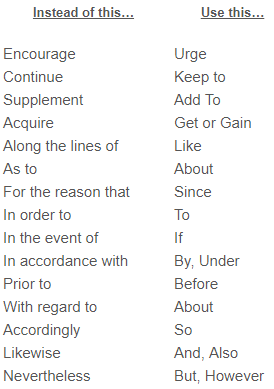
- Contractions Are Your Friend
Your English teachers may not have like contractions. But marketing isn’t English class, so contract away
Think of it this way. You use contractions when you talk, don’t you? Don’t contractions just sound… normal? So why wouldn’t you use them in your marketing?
For fun, let’s remove the contractions from that last paragraph:
Think of it this way. You use contractions when you talk, do not you? Do not contractions just sound… normal? So why would not you use them in your marketing?
See how silly that sounds?
You do not need to contract words in every possible instance. Do it when it sounds natural. You know, how you’d actually TALK.
- Eliminate Filler Words
Every word takes up precious real estate in your ad… and your reader’s mind. Ruthlessly cutting unnecessary words is crucial to a concise, compelling message.
Consider the following:
- “evidence we have” instead of “the evidence we have”
- “consumers” instead of “the consumer”
- That can be left out half (of) the time
- “he said he agreed” instead of “he said that he agreed”
- “the policy anniversary date” instead of “the anniversary date of the policy”
If your ad feels wordy, ask yourself: “What can I cut while remaining grammatically correct?”
- Use Action Verbs
To keep readers engaged, use action verbs. These help paint a picture in your reader’s mind.
Here are some examples:
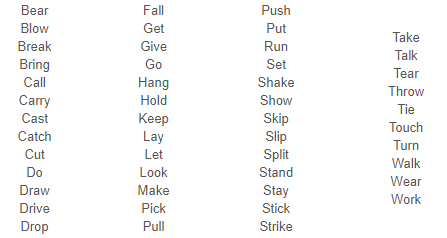
Let’s go back to that Reader’s Digest story of the men lost at sea. Notice all of the action verbs. I’ve underlined the ones that paint a vivid mental picture.
“Alvarenga now spent entire days hunting for turtles. Córdoba, however, was disgusted by the congealed blood and ate sparingly of the meat. Alvarenga seduced his mate into eating by presenting the turtle steaks as a delicacy. He cut the meat into thin strips, dripped on salt water for flavoring, and toasted them in the sun on the outboard motor housing. Using the vertebrae of triggerfish as toothpicks, he served his meal on a turtle shell.”
When you read this, you can’t help but imagine these guys “hunting” and “cutting” and “toasting.”
Bonus Tip: Use Your Word Processor’s Readability Tool
Want to know how easy to understand your copy is? Use your word processor’s readability tool.
Here’s how to check your readability score with the latest versions of Microsoft Word:
- Click the File tab
- Click Options.
- Click Proofing.
- Ensure the “Check grammar with spelling check box” is selected.
- Select “Show readability statistics.”
- After you check a document’s spelling and grammar, readability statistics will now display.
For reference, here is how the Flesch-Kincaid readability scores break down:
–90.0 to 100: Easily understood by average 11-year-old students.
–60.0 to 70.0: Easily understood by 13- to 15-year-old students.
–0.0 to 30.0: Best understood by college graduates. (Try to avoid this in your marketing!)
—-
Bottom Line: Write how people talk.
You’ll engage the reader. They’ll hang on to your every word. And they’ll be MUCH more likely to buy from you.
-Rich
P.S. For more instruction on how to write powerfully, visit the MYM blog. Type “writing” into the search bar, and—presto!—you’ve got a ton of writing resources at your fingertips.
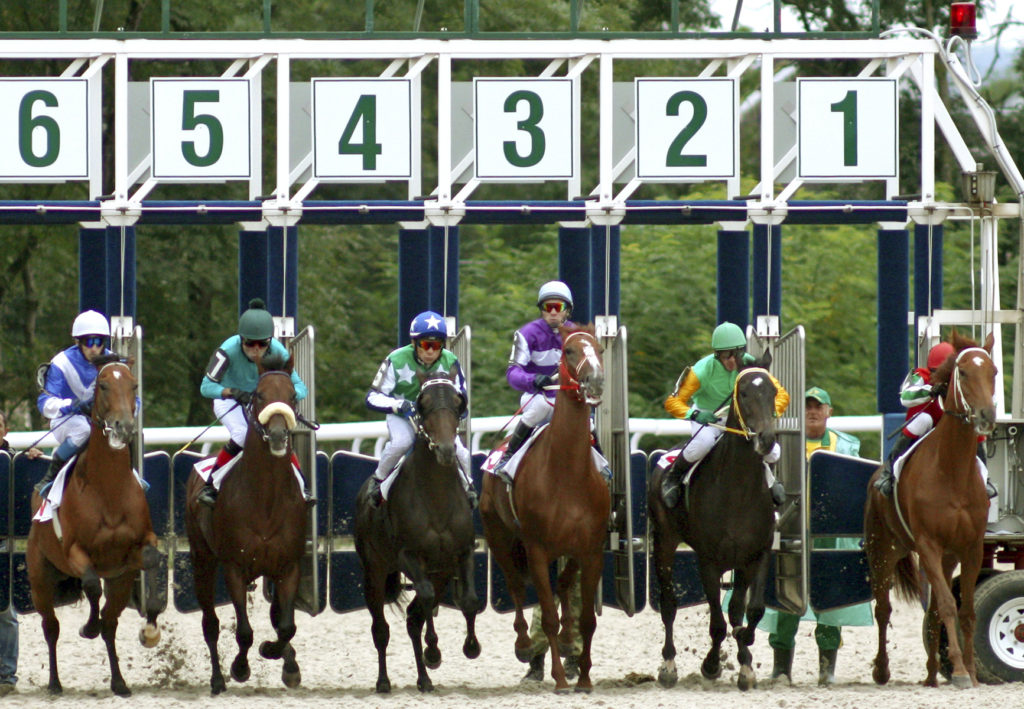
Here are more hot-off-the-presses results for a No-Risk PPC client.
This is particular client is a window company in the western part of the country. From 2/25 to 3/24, we generated 49 PPC leads for the client for an average cost per lead (CPL) of $176.16.
Most home improvement companies would kill for this kind of CPL. But here’s what makes it all the more impressive:
- Window replacement is about as cutthroat as you can get in the home improvement industry.
- This client’s service area is HYPER competitive. You can’t walk 10 steps without running face-first into a window company.
- We launched this client’s campaign on 2/10/18. The campaign is basically still in its infancy. (It’s even still got that fresh “newborn” smell.)

Pictured, right: The client’s campaign.
Let me show you a few of the leads that came through during this period. These images come from the client’s No-Risk PPC report. I’ve removed all identifying info.
Lead 1: As Simple As You Can Get
- Date: 2-26-18
- Time: 9:27pm
- Lead Type: Online Chat
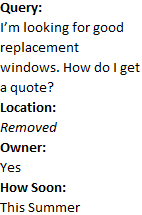
Lead 2: Needs Replacement Windows ASAP
- Date: 3-18-18
- Time: 11:07am
- Lead Type: Online Chat
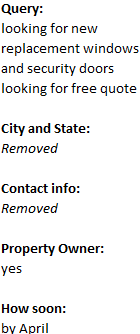
Lead 3: Wants Window Quote Quickly
- Date: 3-24-18
- Time: 5:27pm
- Lead Type: Online Chat
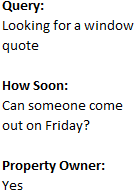
Of course, not everyone who clicks on your PPC ad is a lead. Here’s an example of a non-lead that came through this client’s PPC campaign:
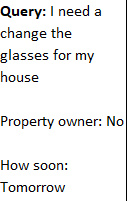
The client doesn’t repair glass. But you’re going to get these types of inquiries from time to time. It’s the nature of PPC.
Where we differ from most PPC providers is that we don’t count this as a lead.
If someone contacts you for a service you don’t provide or from outside your area, you don’t get charged for it. Period.
This is one of the advantages of tracking calls and chats that come from a client’s PPC campaign. Everything is transparent. Everything is accounted for. Everything is 100% accurate.
Discover how No-Risk PPC can help your specific business by…
- Sending an email to noriskppc@mymonline.com.
- Visiting the No-Risk PPC page and filling out the form.
Thanks!
-Rich

I’d like you to look at the recent results for a No-Risk PPC roofing client.
From March 10th to March 24th, we generated 16 PPC leads for this client at a cost of $149.21 per lead. (We report on and invoice for leads every two weeks.)
Here’s a look at the invoice:
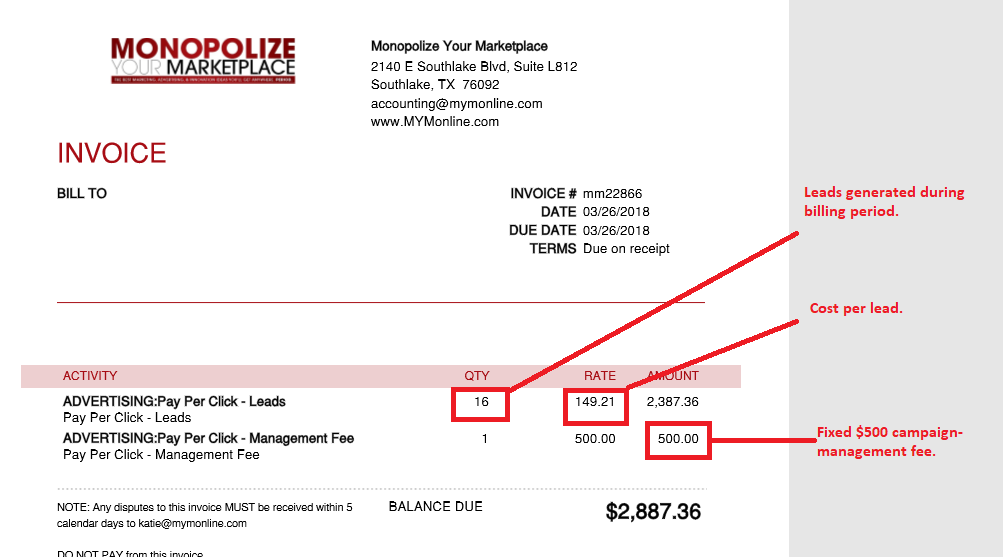
Below are some of the lead queries that came in. The images come from the lead transcripts in our reporting. Identifying info has been removed.
Lead 1
- Date: 3-10-18
- Time: 1:53pm
- Lead Type: Online Chat
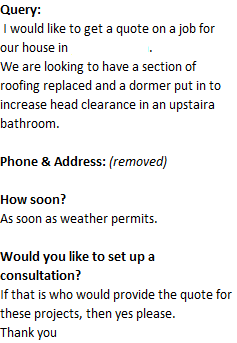
Lead 2
- Date: 3-11-18
- Time: 3:15pm
- Lead Type: Website Form
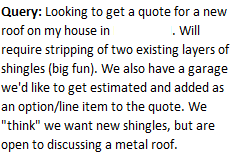
Lead 3
- Date: 3-14-18
- Time: 3:04pm
- Lead Type: Online Chat To Call Connect
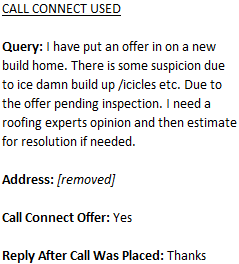
During the previous billing period (February 25th to March 9th), No-Risk PPC generated this client 14 leads at a cost of $145.83 per lead.
In all, that’s 30 leads in one month for less than $150 each.
Keep in mind… this is DURING a brutal winter!
Now that it’s spring, the lead count for this client will almost certainly ratchet up in the coming months. I’ll keep you posted on their progress.
In the meantime, visit the No-Risk PPC page and take 60 seconds to fill out the form. We’ll follow up with information regarding current predicted lead figures in your area and an estimated cost per lead.
Thanks!
Rich
Look for the next post about No-Risk PPC client’s latest results.




















